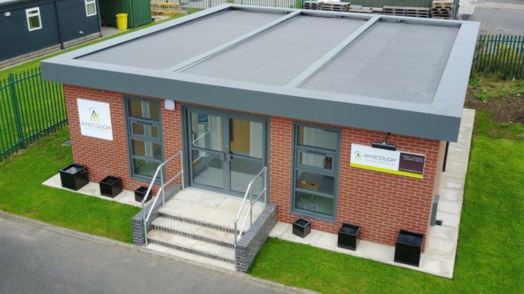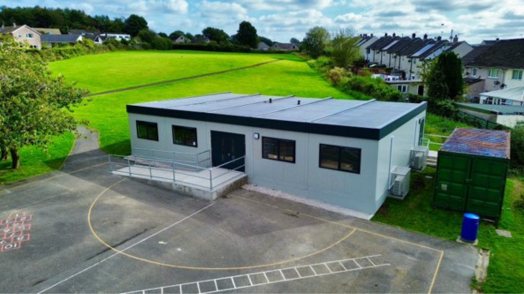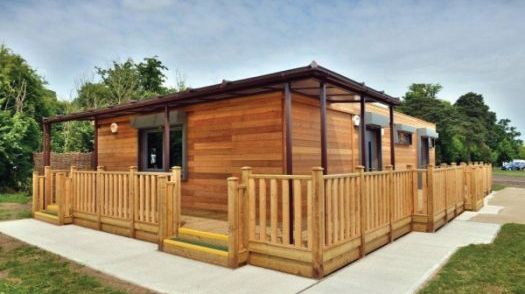Contact our friendly team for more information on our full range of buildings and how to start the process of hiring or buying a modular building for your business. Our expert team is always available to give advice, guidance or support.
Published: 12 August 2024 in Building Types
Sustainable Construction: How Prefabrication Supports Green Building Practices

Traditional construction methods have historically been associated with significant environmental impacts, including excessive waste, resource depletion and pollution. The extraction of raw materials, energy-intensive manufacturing processes, transportation of construction materials, and disposal of construction waste all contribute to environmental degradation and high carbon emissions. Additionally, traditional construction practices often result in buildings with high energy consumption, further exacerbating ecological concerns.
To address sustainability challenges, businesses and schools are now adopting the greener alternative of prefabrication that prioritises energy efficiency, resource conservation, and environmental responsibility during construction. This method of construction also results in more sustainable and environmentally friendly buildings.
This article explores how prefabrication supports green building practices and provides a more sustainable and environmentally friendly alternative to traditional construction methods.
How is a Prefabricated Building Constructed?
Constructing a prefabricated building involves several stages, from design and fabrication to transportation and assembly on-site. Here’s an overview of the process:
- Off-Site Manufacturing: Prefabricated building components, modules, or sections are constructed in a controlled factory environment away from the final building site.
- Site Preparation: While the modules are constructed in the factory, site preparation and groundworks occur concurrently.
- Assembly and Installation: The modules are transported to the construction site, where they are assembled into the final structure.
- Finishing Touches: Once the structural framework is in place, the building’s interior and exterior finishing touches, including plumbing, electrical, insulation, and fixtures, are applied.
In contrast, traditional building methods consist of multiple steps over a substantially longer period to achieve the finished result. This includes site preparation, foundation construction, structural framework, roof and wall installation, finishing touches, and utility work occurring consecutively. This process often takes much longer and is more resource-heavy.
How Does Prefabrication Support Greener Building Practices?
Efficient Use of Raw Materials
Prefabricated building components are constructed to precise specifications in a controlled factory environment. This precision optimises material usage, minimising waste typically associated with on-site construction where materials may be cut or adjusted to fit during installation. As a result, prefabrication often leads to more efficient utilisation of raw materials, reducing overall waste generation.
Faster Construction Times
Prefabrication accelerates construction timelines significantly due to concurrent building and site preparations. The shortened construction period means less time spent on-site, leading to lower energy consumption and disruption to the local area. This efficiency is especially critical in schools and nursery areas where minimising construction time can alleviate the impact on the children’s education.
Transportation Efficiency
Prefabricated components are transported to the construction site in one single delivery, reducing the need for additional on-site labour and the associated fuel consumption and costs. Transporting prefabricated modules in one delivery directly reduces carbon emissions compared to transporting many construction materials individually.
Resource Optimisation
Prefabrication allows for careful planning and optimisation of natural resources. Modular building contractors can accurately estimate material requirements by creating a detailed plan, reducing the risk of overordering and minimising unnecessary resource consumption.
Innovative Materials and Technologies
Prefabrication encourages the use of innovative, sustainable materials and construction technologies. Manufacturers can explore eco-friendly alternatives that enhance the building’s sustainability, such as reclaimed wood, energy-efficient solar panels and automatic windows.
Reusability and Adaptability
Prefabricated buildings are designed for disassembly and reuse, allowing components to be repurposed for new projects. This means that schools and nurseries can start with a single classroom and add additional modules as required. Moreover, if the school or nursery no longer requires the building, it can be transported or sold to another location. This flexibility and adaptability extend the lifecycle of materials and reduce the need for new resources.
As demand for sustainable buildings grows, prefabrication offers a practical and cost-effective solution for creating eco-friendly classrooms that meet the education sector’s needs without the environmental impact.
By adopting green building practices like prefabrication, schools and nurseries can mitigate environmental impact and benefit from long-term cost savings while maintaining a safe and healthy learning environment for their young learners.
Explore our prefabricated buildings for hire or purchase, or read our case studies to learn about the benefits of modular classroom construction.









